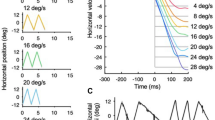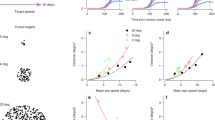Abstract
We propose a quantitative model for human smooth pursuit tracking of a continuously moving visual target which is based on synchronization of an internal expectancy model of the target position coupled to the retinal target signal. The model predictions are tested in a smooth circular pursuit eye tracking experiment with transient target blanking of variable duration. In subjects with a high tracking accuracy, the model accounts for smooth pursuit and repeatedly reproduces quantitatively characteristic patterns of the eye dynamics during target blanking. In its simplest form, the model has only one free parameter, a coupling constant. An extended model with a second parameter, a time delay or memory term, accounts for predictive smooth pursuit eye movements which advance the target. The model constitutes an example of synchronization of a complex biological system with perceived sensory signals.
Similar content being viewed by others
References
Barborica A, Ferrera V (2003) Estimating invisible target speed from neuronal activity in monkey frontal eye field. Nat Neurosci 6:66–74
Barnes GR, Donelan SF (1999) The remembered pursuit task: evidence for segregation of timing and velocity storage in predictive oculomotor control. Exp Brain Res 129:57–67
Barnes GR, Barnes DM, Chakraborti SR (2000) Ocular pursuit responses to repeated, single-cycle sinusoids reveal behavior compatible with predictive pursuit. J Neurophysiol 84:2340–2355
Becker W, Fuchs AF (1985) Prediction in the oculomotor system: smooth pursuit during transient disappearance of a visual target. Exp Brain Res 57:565–575
Bennet S, Barnes G (2004a) Combined smooth and saccadic ocular pursuit during the transient occlusion of a moving visual object. Exp Brain Res 168:313–321
Bennet S, Barnes G (2004b) Predictive smooth ocular pursuit during the transient disappearance of a visual target. J Neurophysiol 92:578–590
de Brouwer S, Yuksel D, Blohm G, Missal M, Lefèvre P (2002) What triggers catch-up saccades during visual tracking? J Neurophysiol 87:1646–1650
Calvo O, Chialvo DR, Eguiluz VM, Mirasso C, Toral R (2004) Anticipated synchronization: a metaphorical linear view. Chaos 14:7–13
Carey MR, Lisberger SG (2004) Signals that modulate gain control for smooth pursuit eye movements in monkeys. J Neurophysiol 91:623–631
Carl JR, Gellman RS (1987) Human smooth pursuit: stimulus-dependent responses. J Neurophysiol 57:1446–1463
Churchland AK, Lisberger SG (2002) Gain control in human smooth-pursuit eye movements. J Neurophysiol 87:2936–2945
Churchland MM, Chou I, Lisberger SG (2003) Evidence for object permanence in the smooth-pursuit eye movements of monkeys. J Neurophysiol 90:2205–2218
Cimponeriu L, Rosenblum M, Pikovsky A (2004) Estimation of delay in coupling from time series. Phys Rev E 70:046–213
Ciszak M, Toral R, Mirasso C (2004) Coupling and feedback effects in excitable systems: anticipated synchronization. Modern Phys Lett B 18:1135–1155
Dallos PJ, Jones RW (1963) Learning behaviour of the eye fixation control system. IEEE Trans Acoust 8:218–227
Diekmann O, van Gils SA, Lunel SMV, Walther HO (1995) Delay equations. Springer, Berlin Heidelberg New York
Eurich CW et al. (2000) Delay adaptation in the nervous system. Neurocomputing 32–33:741–748
Ferrera VP, Lisberger SG (1995) Attention and target selection for smooth pursuit eye movements. Neurosci 15:7472–7484
Frank TD, Friedrich R, Beek PJ (2005) Identifying and comparing states of time-delayed systems: phase diagrams and applications to human motor control systems. Phys Lett A 338:74–80
Fukushima K et al. (2002) Coding of smooth eye movements in three-dimensional space by frontal cortex. Nature 419:157–162
Glass L (2001) Synchronization and rhythmic processes in physiology. Nature 410:277–284
Goldreich D, Krauzlis RJ, Lisberger SG (1992) Effect of changing feedback delay on spontaneous oscillations in smooth pursuit eye movements of monkeys. J Neurophysiol 67:625–638
Gopalsamy K (1992) Stability and oscillations in delay differential equations of population dynamics. Kluwer, Dordrecht
Gottlieb J, MacAvoy M, Bruce C (1994) Neural responses related to smooth-pursuit eye movements and their correspondence with electrically elicited smooth eye movements in the primate frontal eye field. J Neurophysiol 72:1634–1653
Grimm RJ, Nashner LM (1975) Long loop dyscontrol. In: Desmedt JE (ed) Cerebral motor control in man: long loop mechanisms. Progr in Clin Neurophysiol, vol 4. Karger, Basel, pp 70–84
Hale JK, Verduyn Lunel S (1993) Introduction to functional differential equations. Springer, Berlin HeidelBerg New York
Heywood S, Churcher J (1971) Eye movements and the afterimage—1. Tracking the afterimage. Vision Res 11:1163–1168
von Hofsten C (2004) An action perspective on motor development. Trends Cognit Sci 8:266–272
Horbelt W, Timmer J, Voss HU (2002) Parameter estimation in nonlinear delayed feedback systems from noisy data. Phys Lett A 299:513–521
Jones M (1976) Time, our lost dimension: toward a new theory of perception, attention, and memory. Psychol Rev 83:323–355
Just W, Benner H, Scholl E (2003) Control of chaos by time-delayed feedback: a survey of theoretical and experimental aspects. Adv Solid State Phys 43:589–604
Kahlon M, Lisberger SG (2000) Changes in the responses of Purkinje cells in the floccular complex of monkeys after motor learning in smooth pursuit eye movements. J Neurophysiol 84:2945–2960 (2000)
Kao GW, Morrow MJ (1994) The relationship of anticipatory smooth eye movement to smooth pursuit initiation. Vision Res 34:3027–3036
Kettner RE, Suh M, Davis D, Leung HH (2002) Modeling cerebellar flocculus and paraflocculus involvement in complex predictive smooth eye pursuit in monkeys. Ann N Y Acad Sci 978:445–467
Kowler E, Steinman RM (1979) The effect of expectations on slow oculomotor control—I. Periodic target steps. Vision Res 19:619–632
Krauzlis RJ (2004) Recasting the smooth pursuit eye movement system. J Neurophysiol 91:591–603
Krauzlis RJ (2005) The control of voluntary eye movements: new perspectives. Neuroscientist 11:124–137
Krauzlis RJ, Lisberger SG (1994) A model of visually-guided smooth pursuit eye movements based on behavioral observations. J Comp Neurosci 1:265–283
Lencer R, et al. (2004) Cortical mechanisms of smooth pursuit eye movements with target blanking. An fMRI study. Eur J Neurosci 19:1430–1436
Leung HC, Suh M, Kettner RE (2000) Cerebellar flocculus and paraflocculus Purkinje cell activity during circular pursuit in monkey. J Neurophysiol 83:13–30
Licklider JCR (1951) A duplex theory of pitch perception. Experimentia 7:128–134
Liston D, Krauzlis RJ (2003) Shared response preparation for pursuit and saccadic eye movements. J Neurosci 23:11,305–11,314 (2003)
van Loon EM, Hooge IT, van den Berg AV (2002) The timing of sequences of saccades in visual search. Proc R Soc Lond B Biol Sci 269:1571–1579
Madelain L, Krauzlis RJ (2003) Effects of learning on smooth pursuit during transient disappearance of a visual target. J Neurophysiol 90:972–982
Malek-Zavarei M, Jamshidi M (1987) Time-delay systems: analysis, optimization and applications. North-Holland
Martin T, Egly R, Houck JM, Bish JP, Barrera BD, Lee DC, Tesche CD (2005) Chronometric evidence for entrained attention. Percept Psychophys 67:168–184
Medina JF, Carey MR, Lisberger SG (2005) The representation of time for motor learning. Neuron 45:157–167
Mosekilde E, Maistrenko Y, Postnov D (2002) Chaotic synchronization: applications to living systems. World Scientific, Singapore
von Norden GK, Mackensen G (1962) Pursuit movements of normal and amblyopic eyes. An electro-ophthalmographic study. I. Physiology of pursuit movements. Am J Ophthalmol 53:325–336
Nudelman HB, Herberich KE, Hoyt BD, Rosenfield DB (1989) A neuroscience model of stuttering. J Fluency Disord 14: 399–427
Pikovsky A, Rosenblum M, Kurths J (2001) Synchronization—a universal concept in nonlinear science. Cambridge University Press, Cambridge
Rashbass C (1961) The relationship between saccadic and smooth tracking eye movements. J Physiol 159:326–338
Reddy BAJ, Carpenter RHS (2000) The influence of urgency on decision time. Nat Neurosci 3:827–830
Ringach DL (1995) A ’tachometer’ feedback model of smooth pursuit eye movements. Biol Cybern 73:561–568
Robinson D (1965) The mechanics of human smooth-pursuit eye movement. J Physiol (London) 180:569–591
Robinson DA (1989) Integrating with neurons. Ann Rev Neurosci 12:33–45
Rosenbaum DA (2002) Time, space, and short-term memory. Brain Cognit 48:52–65
Siegert S, Friedrich R, Peinke J (1998) Analysis of data sets of stochastic systems. Phys Lett A 243:275–280
Stone LS, Krauzlis RJ (2003) Shared motion signals for human perceptual decisions and oculomotor actions. J Vis 3:725–736
Stone LS, Lisberger SG (1990a) Visual responses of Purkinje cells in the cerebellar flocculus during smooth-pursuit eye movements in monkeys. I. Simple spikes. J Neurophysiol 63:124–126
Stone LS, Lisberger SG (1990b) Visual responses of Purkinje cells in the cerebellar flocculus during smooth-pursuit eye movements in monkeys. II. Complex spikes. J Neurophysiol 63:1262–1275
Strogatz SH (2001) Exploring complex networks. Nature 410:268–276
Sturm AK, König P (2001) Mechanisms to synchronize neuronal activity. Biol Cybern 84:153–172
Suh M, Leung HC, Kettner RE (2000) Cerebellar flocculus and ventral paraflocculus Purkinje cell activity during predictive and visually driven pursuit in monkey. J Neurophysiol 84:1835–1850
Tang S, Liu JM (2003) Experimental verification of anticipated and retarded synchronization in chaotic semiconductor lasers. Phys Rev Lett 90:194–101
Todorov E (2004) Optimality principles in sensorimotor control. Nat Neurosci 7:907–915
Toral R et al. (2003) Characterization of the anticipated synchronization regime in the coupled FitzHugh-Nagumo model for neurons. Physica A 325:192–198
Varela F, Lachaux JP, Rodriguez E, Martinerie J (2001) The brainweb: phase synchronization and large–scale networks. Nat Rev Neurosci 2:229–239
Voss HU (2000) Anticipating chaotic synchronization. Phys Rev E 61:5115–5119
Voss HU (2001a) A backward time shift filter for nonlinear delayed-feedback systems. Phys Lett A 279:207–214
Voss HU (2001b) Dynamic long-term anticipation of chaotic states. Phys Rev Lett 87:014–102
Voss HU (2002a) Fast response by synchronization. In: Hoffmann KH (ed) 2nd Caesarium—coupling of biological and electronic systems. Springer, Berlin Heidelberg New York, pp 119–126
Voss HU (2002b) Real-time anticipation of chaotic states of an electronic circuit. Int J Bifurcat Chaos 12:1619–1625
Voss HU (2003) Synchronization of reconstructed dynamical systems. Chaos 13:327–334
Voss H, Kurths J (1997) Reconstruction of nonlinear time delay models from data by the use of optimal transformations. Phys Lett A 234:336–344
Wells SG, Barnes GR (1998) Fast, anticipatory smooth-pursuit eye movements appear to depend on a short-term store. Exp Brain Res 120:129–133
Author information
Authors and Affiliations
Consortia
Corresponding author
Additional information
Cognitive and Neurobiological Research Consortium in Traumatic Brain Injury (CNRC-TBI).
Rights and permissions
About this article
Cite this article
Voss, H.U., McCandliss, B.D., Ghajar, J. et al. A quantitative synchronization model for smooth pursuit target tracking. Biol Cybern 96, 309–322 (2007). https://doi.org/10.1007/s00422-006-0116-2
Received:
Accepted:
Published:
Issue Date:
DOI: https://doi.org/10.1007/s00422-006-0116-2




